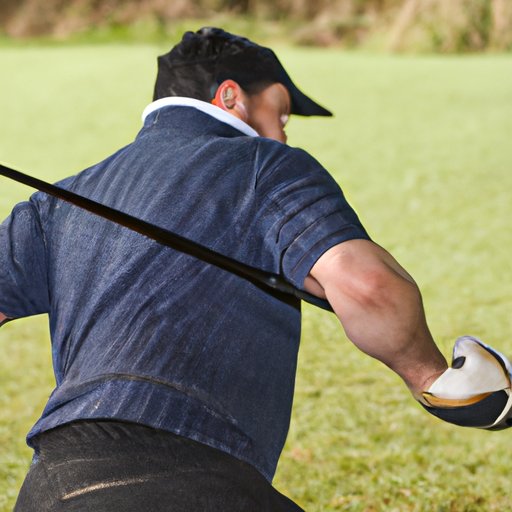
I. Introduction
Golf is a challenging game that requires precision, skill and patience. Improving your golf swing is essential to playing a good game, and mastering it requires patience, practice, and proper technique. In this article, we will outline different strategies for improving your golf swing that cover everything from grip and posture to swing speed and strategic thinking.
II. Mastering the basics: How perfecting your grip can improve your golf swing
The importance of having a proper grip on golf club cannot be overstated. It is the foundation on which everything else depends. With a good grip, golfers can get the ball on the target with greater accuracy and consistency. As a result, learning and perfecting the right grip should be the first step to improve your golf game.
To achieve the proper grip, start by gripping the club with your left hand with your thumb toward your right hand (for right-handed golfers). Insert the fingers of your right hand in the spaces between your left hand’s fingers. Both of your thumbs should be pointing down the club’s shaft. The “V” made by the thumb and index fingers of both hands should point toward your right shoulder. Make sure your hands and fingers have a firm, yet relaxed grip.
It’s also important to maintain the correct grip throughout your swing. Do not grip your golf club too tightly as it may cause the clubface to twist and negatively affect your swing. Instead, focus on maintaining a relaxed grip by keeping your hands, wrists, and forearms soft and in position.
III. Achieving optimal impact: Understanding the correct stance and posture for hitting the ball
Having good posture when taking your shot is vital for proper impact position. The impact position happens when your clubface makes contact with the ball, and the right stance and posture are crucial for achieving it. With the right positioning, golfers can hit the ball with more power and precision.
Align your feet shoulder-width apart, with the ball positioned about two golf balls’ length away from you. Your knees should be slightly bent, and your weight should be evenly distributed on both feet. Your head and spine should be straight, with the chin up, and your eyes directly focused on the ball.
The correct posture for hitting a golf ball involves keeping your arms straight, shoulders back, and chest facing the ball. Your elbows should be close to your body, but not pressed against your ribcage. Avoid standing too close or far away from the ball; it should be positioned just in front of you and directly in line with your front shoulder. By maintaining a good stance and posture throughout the swing, golfers can achieve optimal impact.
IV. Maximizing your swing speed: Tips on increasing power and distance in your shots
The power and speed of your swing are essential for propelling the ball greater distances while maintaining accuracy. Having adequate swing speed also helps in overcoming water hazards, sand traps, and reaching greens in fewer strokes. Here are some tips for golfers who want to increase their swing speed:
Start by ensuring that the clubface is square at setup. This helps to generate maximum power on the downswing since your clubface strikes the ball at the ideal angle. Then, focus on shifting your weight from your front foot to your back foot as you start your backswing. This provides the power needed for propelling your swing as you begin your downswing. And as you transfer your weight to your front foot, focus on rotating your hips as you swing through and hit the ball. It is also essential to keep your arms extended, maintain good posture and avoid swinging too hard.
V. Playing with a plan: Strategic thinking to improve accuracy and consistency on the course
Golf is not just about swinging the club but also about playing with a plan. A pre-shot routine and course management strategy help golfers improve their accuracy and consistency in their shots. To develop a pre-shot routine, start by taking deep breaths to stay calm and focused. Next, visualize your shot by considering the distance, wind speed, and direction, and then pick a suitable target on the fairway. Finally, execute the swing and trust the process.
When faced with challenging situations, try to focus on short-term goals and break the game down into achievable shots. Make use of any time between holes to plan your next shot. For instance, mapping out the greens in advance helps you to have a better understanding of the course and develop personalized strategy to improve play. Also, if you find that certain clubs or types of shots tend to cause problems, consider changing your approach and strategy.
VI. Mental game mastery: Overcoming nerves and focusing for success on the green
Mastering the mental game of golf is just as important as perfecting your physical technique on the course. The mental aspect of the game has a significant impact on results. To avoid feeling overwhelmed and nervous, focus on one shot at a time and be confident in your technique and abilities.
Staying focused is essential to avoid distractions on the course. Before hitting a shot, take the time to clear your head and focus on the ball and your targets. Trying to stay present in the moment and visualize the outcome you desire helps with maintaining focus and calmness and minimizing stress. Avoid worrying about mistakes or past performance, instead, have faith in your abilities and the process.
VII. Conclusion
Improving your golf swing requires dedication, patience, and practice in applying the right technique and strategy. By perfecting these basics, getting the optimal impact position, increasing your speed, developing a course management plan, and mastering your mental game, golfers can enhance their swing, achieve greater distance and accuracy, and lower their scores. It’s time now to put the tips into practice and enjoy the game.




